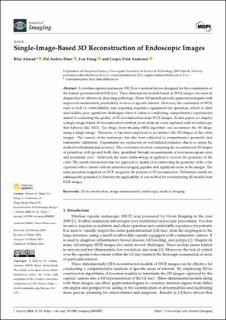| dc.description.abstract | A wireless capsule endoscope (WCE) is a medical device designed for the examination of the human gastrointestinal (GI) tract. Three-dimensional models based on WCE images can assist in diagnostics by effectively detecting pathology. These 3D models provide gastroenterologists with improved visualization, particularly in areas of specific interest. However, the constraints of WCE, such as lack of controllability, and requiring expensive equipment for operation, which is often unavailable, pose significant challenges when it comes to conducting comprehensive experiments aimed at evaluating the quality of 3D reconstruction from WCE images. In this paper, we employ a single-image-based 3D reconstruction method on an artificial colon captured with an endoscope that behaves like WCE. The shape from shading (SFS) algorithm can reconstruct the 3D shape using a single image. Therefore, it has been employed to reconstruct the 3D shapes of the colon images. The camera of the endoscope has also been subjected to comprehensive geometric and radiometric calibration. Experiments are conducted on well-defined primitive objects to assess the method’s robustness and accuracy. This evaluation involves comparing the reconstructed 3D shapes of primitives with ground truth data, quantified through measurements of root-mean-square error and maximum error. Afterward, the same methodology is applied to recover the geometry of the colon. The results demonstrate that our approach is capable of reconstructing the geometry of the colon captured with a camera with an unknown imaging pipeline and significant noise in the images. The same procedure is applied on WCE images for the purpose of 3D reconstruction. Preliminary results are subsequently generated to illustrate the applicability of our method for reconstructing 3D models from WCE images. | en_US |

